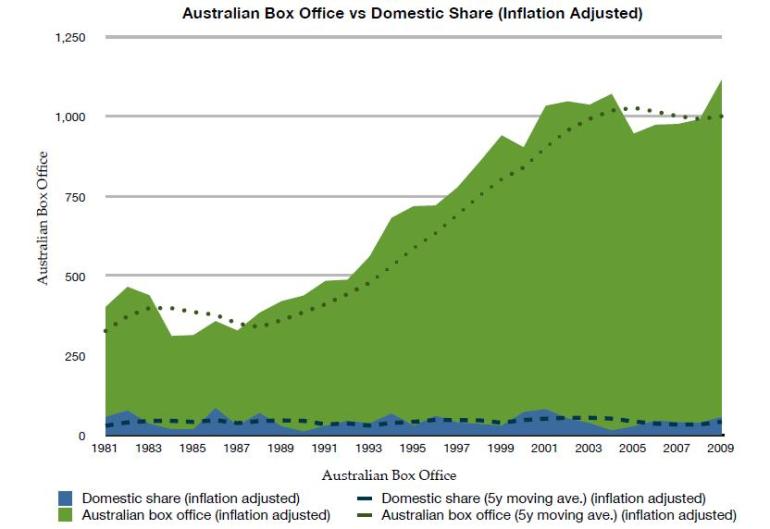The performance of Australian films has failed to keep pace with the spectacular rise in inflation-adjusted box office returns over the past three decades, according to new research.
While local films’ total box office returns have more than doubled from $24.2 million in 1981 to $54.8 million in 2009, the total box office has grown at an even faster rate (see graph below).
“The exponential growth has been nothing short of extraordinary given the period has spanned the rise of home entertainment, from VHS to DVD to online distribution,” Convergen managing director Anton Andreacchio, who conducted the research, said.
“It does though paint a fairly bleak picture of the competitiveness of Australian product at the box office, which has failed to capitalize on the soaring overall demand.”
Local films' proportion of total box office peaked in 1986 with 23.5 per cent (due to Crocodile Dundee) and recorded a low of 1.3 per cent in 2004. In the past decade, Australian films take of the total box office has exceeded five per cent just twice (in 2001 with 7.8 per cent and 2010 with five per cent).
Andreacchio said the inflation-adjusted domestic box office, compared to the total box office, is almost completely flat, suggesting issues with distribution.
“It could be argued that we should have seen strong volatility in the domestic component over the past few decades given the level of volatility in the total box office, which should also have been compounded by the changes in tax incentives, funding sources, government intervention, etc.
"The absence of this and stability of domestic box office turnover clearly suggests that there are constraints on the demand-side (distribution) that are not affected by all the supply-side (production) manoeuvring."
Convergen’s technology services include feature film visual effects and architectural and urban planning applications. It is based in South Australia in the same offices as AMPCO Films, which recently produced Australian-Chinese co-production The Dragon Pearl.
The Screen Producers Association of Australia is lobbying the government to introduce a $60 million Producer Distributor Film Fund (PDFF), which it hopes will increase the number of locally-made mid-budget, commercial films.
The PDFF is aimed at producing more mid-budget films in the $7 – $30 million budget range, potentially doubling the Australian share of the $1 billion local box office to about 10 per cent, while creating about 900 jobs.
A five year moving average and area graph have been used to aggregate the short term fluctuations in both the domestic share and total box office.Source: Convergen.


